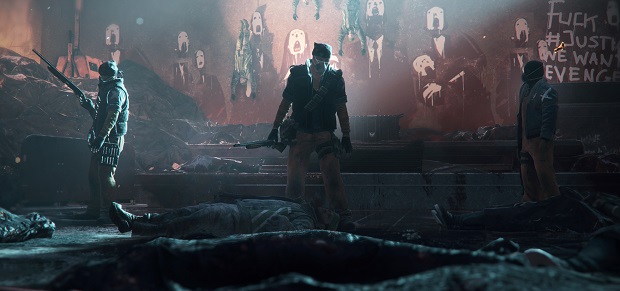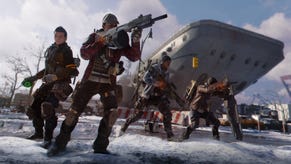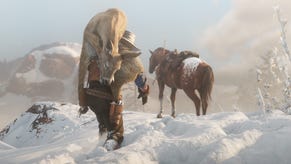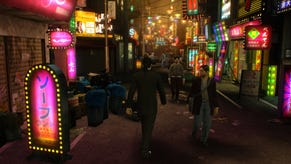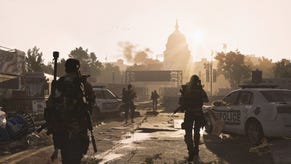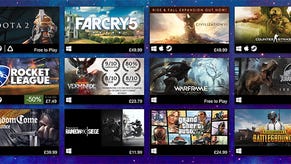A Tactical ARPG: Hands-On With The Division
An unusual cocktail
The Division [official site] is, initially, a confusing game. All of the individual pieces make a certain kind of sense, but the combination doesn't quite hang together. It's like ordering tempura and getting a thick, creamy, eggy mayonnaise on the side in place of a good Tentsuyu dipping sauce. Both parts of the dish are enticing on their own but the combination is an acquired taste at best. I spent three hours playing the game this week and I'm still not sure if this is a taste I'll ever be fully on board with - it's an unusual game though and far more interesting than it's gruff near-future shootybangs had led me to expect.
What are these two flavours then? On the one hand there's a half-imagined half-recreated New York, at almost 1:1 scale, packed with characters who look as real as anyone I've ever met in a game. They're dirty, they're ragged, they're desperate. One named character has the most convincingly wince-worthy limp I can remember seeing in a game, and the marauding mobs of looters and other sinisters groups fit in with the smokey, blown-out grime of the streets.
It's a handsome depiction of a hellish situation. The Division takes place in New York post-disaster but pre-apocalypse – perhaps mid-disaster would be more accurate – and part of the initial appeal is in seeing how sights both famous and mundane have been transformed. As one of those who claims, tongue in vicinity of cheek, that Die Hard is the greatest Christmas film (RIP Rickman), I was pleased to see splashes of colourful decoration among the death and debris.
This is a near-future Christmas period and, thematically, The Division's visual design reflects the destruction of beauty as well as the excess that may have paved the way toward ruin. The infection that brought the city to its knees – or at least allowed those who took advantage of the chaos to bring the city to its knees – spread during the Black Friday sales, reproductions of which are seen in the live action intro. It's like watching another remake of Dawn of the Dead.
The infection is laced on banknotes, which gives me hope that the spread of contactless payments will prevent a similar situation arising in the real world. Having money as the Trojan Horse also feeds into the Fall of Rome theme – consumerism as a virus and the rich eating themselves.
That's the tempura. The big dollop of mayonnaise is everything else, including the things you'll be doing while playing the game. Shooting, crafting, collecting, cooperating, betraying and extracting. It's a busy game, though I wasn't overwhelmed by icons, but everything from the fidelity of the graphics to the beautifully smooth cover system led me to expect combat that would transmit at least a sense of the same threat and realism.
Instead, I found myself pouring clip after clip of ammunition into enemies that are not so much bullet sponges as humanoid tardigrades, capable of surviving even the blast and flame resulting from a direct hit with an incendiary grenade. The Division, y'see, has more in common with Bungie's Destiny than it does with Ghost Recon, Rainbow Six or anything else in the big, wide Clancyverse.
For those who haven't played Destiny (myself included), the comparison isn't particularly useful. Essentially, The Division has all the shooting and cover systems of an accomplished third-person action game combined with looting and killing systems reminiscent of an ARPG. Guns, which look very much like the real thing, have damage per second (DPS) ratings and everything from their range to their recoil can be tweaked using parts found while looting corpses or supply drops throughout the city.
Structurally, around three hours with the game suggests it'll find a decent flow, at least in its early stages. I played a few missions, selected from a steadily growing pile, with a low level character and then jumped into the high level stuff for a high stakes story mission. Aside from the addition of some nifty new skills that allowed me to deploy trundling BB-8-esque drones and chuck defensive structures right onto the battlefield, the experience of being a level 20 character didn't seem drastically different from the level 5 experience.
A couple of clips were enough to take down a regular grunt and bosses required the concentrated attention of our three-person squad. The world doesn't level to match your agents but different areas of the city are clearly marked as being suitable for players within a certain experience range. You're more than welcome to wander into high-level zones right from the start but doing so is likely to end in death and disappointment. At level 5, one encounter with a level 18 enemy taught me that one shot can kill, if the circumstances are right. He dropped me with a single shotgun blast.
It'll take more time with the game to figure out if it's possible to venture into higher level areas successfully. Blundering through the Dark Zone, I figured out the distance at which I could safely skirt around overpowered enemy groups and got a kick out of creeping behind them, staying in cover and out of sight. I even managed to steal some loot while they were looking in the opposite direction but the extraction didn't quite go to plan...
How The Division's Dark Zone works
The aforementioned Dark Zone is my favourite part of the game, and the extraction mechanic that is a fundamental part of that zone might well be the embellishment that elevates the game into something truly desirable. The Dark Zone is a contaminated area, a huge chunk of the map that has been sealed to prevent the spread of infection. You can enter at any time, with no loading screens to interrupt your session, and the area is layered so that the deeper you venture, the more likely you are to run into groups of lethal enemies.
Here's where you're more likely to see the variety of enemy types that make taking back the streets slightly trickier and more engaging than the typical looters, with their baseball bats, machetes and shoddy firearms. There are groups dressed in police uniforms but they're not cops gone rogue; they're prisoners who've escaped from Rikers Island and gone on a rampage, trying to take control of the city. Then there are the Cleaners, gangs of blue collar workers who have wrapped themselves in hazmat gear, grabbed flamethrowers, and decided to burn NYC until it's purged of the infection. They're not taking the time to distinguish between the weak and the wounded, and those who are actually infected though.
In the Dark Zone, everything is infected, including the equipment you collect. Loot attaches to your back in the form of a bright yellow canister and if you leave the zone, it's lost for good. The only way to retrieve and cleanse it is to call in a helicopter for extraction. This can be done at specific points within the zone. The pilot lobs down a rope, you attach the canister and the loot appears in your stash back at HQ.
Unfortunately for you - but fortunately for those who enjoy tension and a sense of personal vulnerability within their loot-based shooters – calling in the extraction alerts everyone in the vicinity. That includes NPCs and other players alike. The Dark Zone is the only place were PvP is allowed and even your own squadmates can jump out of the group you've formed and shoot you in the back if they're particularly hungry for your loot.
There are consequences. Fire on another player and you're designated as an agent “Gone Rogue”, which alerts everyone on the server to your actions. Continue to play as a bastard and a bounty attaches to your head, rewarding anyone who takes the time to hunt you down.
I had a sense while playing, perhaps undeserved, that the areas outside the Dark Zone are where the majority of the plot and scripted missions have landed, and that in the hoped-for post-release free updates and paid expansions, it'll be the Dark Zone (or something like it) that receives a great deal of the attention. It captures a sense of anxiety and of being cut-off in a world gone to hell that the mainstreets of Loot City don't really reach for.
A thinking person's ARPG
There's a sense of comfort food to the bulk of the game – all of that lovely mayonnaise – that sits at odds with the grim cutscenes showing executions and torture. I'm not entirely convinced that the two flavours are ever going to feel quite right together, but by the end of my time with the game, I'd started to enjoy both. And now I'm craving more. In particular, the abililty to switch between roles without tying yourself to a class is fantastic – I was a machinegunning heavy with area effect healing effects that I could dump into the field. There's a great deal of customisation to discover and a high degree of flexibillity in playstyles thanks to the variety of skills, equipment, buffs and grenades.
It's the ARPG loop of exploring and collecting that'll provide the lasting appeal, but it's bolstered by the combat itself, which is about positioning as well as DPS. Having the right numbers in your inventory is all well and good, but being able to coordinate with team-mates so that enemies are suppressed, pinned down, flanked or scattered by grenades is vital. I remember when Clancy games, and Rainbw Six in particular, were the thinking person's shooter. The Division is at least attempting to be a thinking person's ARPG.
The HQ building that you'll bring back to life by introducing resources and rescued personnel is like a second character to upgrade and customise, and the city changes as you play. It's not the static world of an MMO and, indeed, the entire game can be played solo. Given how well the multipayer combat works, allowing you to outsmart and outflank AI characters, I'm not convinced solo play will be all that enjoyable, but I'm glad the option is there. And you'll only need one chum to enjoy most of the benefits that come from playing together.
I'm keen to see more of the crafting and modification systems, which seemed somewhat untidy and unnecessary at first encounter. When I saw a box of fabric marked on my map, alongside random encounters and cries for help about hostage situations and other serious business, I had no desire to investigate. Finding scopes and barrels to modify guns was fun – and everything is thankfully re-usable – but stitching together a new pair of pants might have taken me into one crafting screen too many.
There's more to say, including an entire feature on the brilliance of the UI (it feels like an intelligent extension of Dead Space's legibility) and the game's infrastructure. That'll come later, along with words from creative director Magnus Jansen, whose previous credits include World in Conflict.
The Division has been a long time coming and I had no idea what kind of game I'd be playing until I sat down with it a couple of days ago. It's a far more effective blend of ideas than I'd expected but I can't quite get past the dissonance between the setting and the style of play. Whether it'll matter in the long run, I can't say – it only took me fifteen minutes to get used to the idea that a man in a hoodie can take 30 bullets right in the chest. Maybe it's odd that I'd accept that so readily if he were twelve feet tall or a wizard.
But there is a clash between the costume and the body underneath. I'd love to play a Ghost Recon game set in this world, or a Rainbow Six. I'd like to play more of The Division as well but I'm not entirely sure it needs such a beautiful city in which to rattle off its stat-heavy combat.
The Division's beta will run from Jan 29th to 31st.




